A South African friend introduced me to biltong a few years ago, and as a dried meat I like it quite a bit more than the jerky I usually make. The flavor and texture are worlds apart. I'm using a fairly standard recipe, but on the simpler side. He uses a traditional drying box, but because I already have too many gadgets I use a regular dehydrator.
I found top round at a good price, and then found a petit sirloin roast the next day, so this prep contains both. Unfortunately I do not have a pic of the marinade, but I placed the meat in this pic in a single layer in a vacuum bag, then marinated for 36 hours under vacuum massaging/flipping every few waking hours to ensure an even exposure to the marinade.

I'm using my regular 10-tray dehydrator. I used 5 of the 10 trays.

To ensure I complete the proper dryness, I record the weight of each steak on a paper "map" of sorts. Then periodic weighing during the process ensures the proper dryness. I aim for a 50% reduction in weight for the proper texture (for me).

I dry the steaks flat rather than using the traditional hanging method. The scale fits just right on top of the dehydrator.

All completed. These are most of the steaks, but some were removed (and eaten) because they were thinner therefore drying quicker (a tough job but someone has to do it) .
.

The finished product. These are at 50% of the initial weight. The marinade was light, flavorful, and spicy but not too strong. The texture was silky smooth - almost identical to prosciutto, which is a favorite of mine. The spice adhered perfectly. What kind of looks like a smoke ring is not tough nor crispy - just a pleasant chew. I have tried different degrees of dryness, and have steaks that I've taken up to 75% for my guests that do not like the pink look

Just another view of my setup: a regular dehydrator with temperature and time separately controlled. I set it to the minimum for the first few hours of the process, then turned off the temperature entirely, only using the fan to complete the dry. The temperature of the kitchen was high 60-ish to low 70-ish and about 45% humidity on average. This environment allowed me to weigh regularly during the day removing anything that reached proper dryness. The process is slow enough so I could get a full night's sleep, weighing first thing in the morning. It was slow enough so I did not experience any over-drying.

I found top round at a good price, and then found a petit sirloin roast the next day, so this prep contains both. Unfortunately I do not have a pic of the marinade, but I placed the meat in this pic in a single layer in a vacuum bag, then marinated for 36 hours under vacuum massaging/flipping every few waking hours to ensure an even exposure to the marinade.
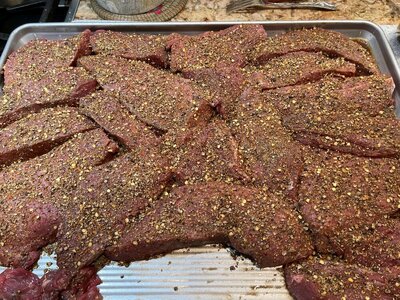
I'm using my regular 10-tray dehydrator. I used 5 of the 10 trays.
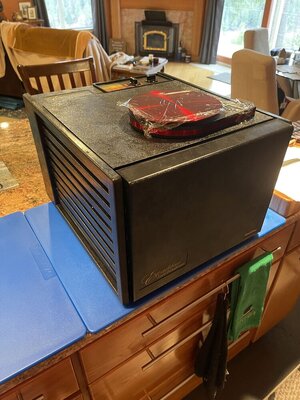
To ensure I complete the proper dryness, I record the weight of each steak on a paper "map" of sorts. Then periodic weighing during the process ensures the proper dryness. I aim for a 50% reduction in weight for the proper texture (for me).
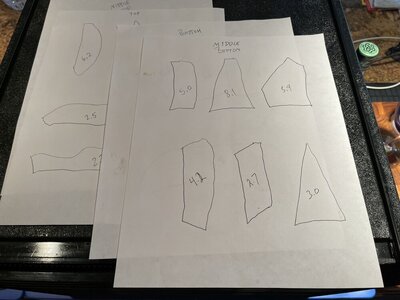
I dry the steaks flat rather than using the traditional hanging method. The scale fits just right on top of the dehydrator.
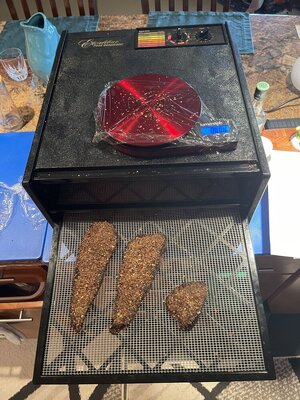
All completed. These are most of the steaks, but some were removed (and eaten) because they were thinner therefore drying quicker (a tough job but someone has to do it)
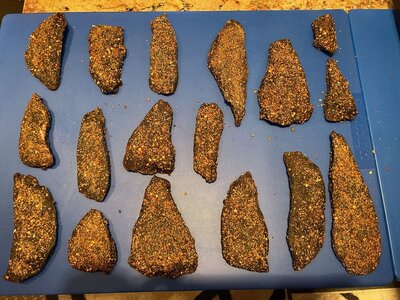
The finished product. These are at 50% of the initial weight. The marinade was light, flavorful, and spicy but not too strong. The texture was silky smooth - almost identical to prosciutto, which is a favorite of mine. The spice adhered perfectly. What kind of looks like a smoke ring is not tough nor crispy - just a pleasant chew. I have tried different degrees of dryness, and have steaks that I've taken up to 75% for my guests that do not like the pink look

Just another view of my setup: a regular dehydrator with temperature and time separately controlled. I set it to the minimum for the first few hours of the process, then turned off the temperature entirely, only using the fan to complete the dry. The temperature of the kitchen was high 60-ish to low 70-ish and about 45% humidity on average. This environment allowed me to weigh regularly during the day removing anything that reached proper dryness. The process is slow enough so I could get a full night's sleep, weighing first thing in the morning. It was slow enough so I did not experience any over-drying.






